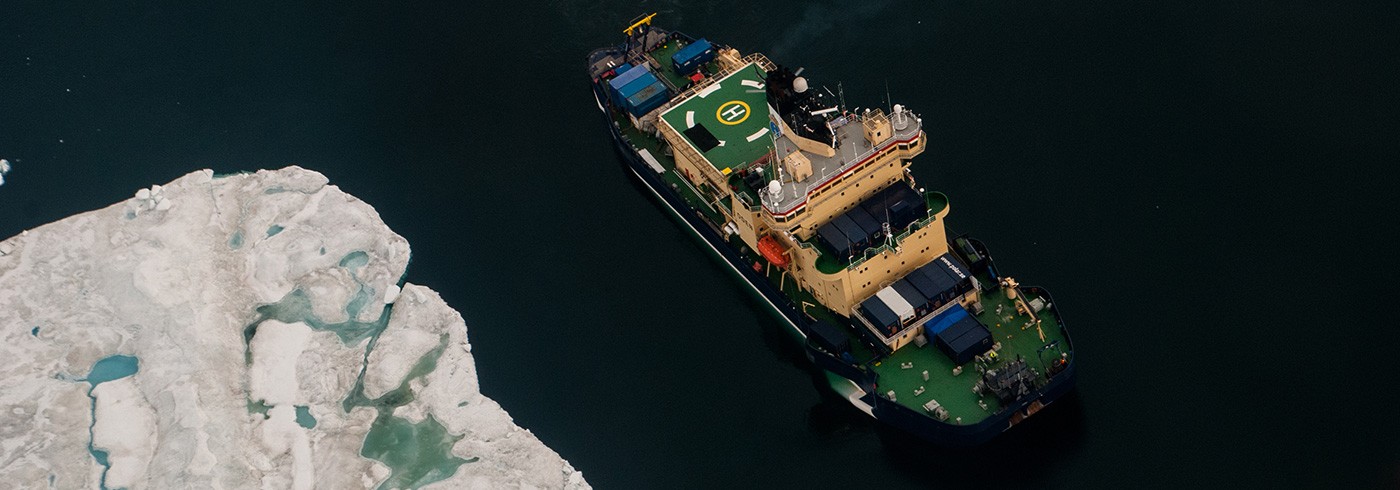Ice is a complicated and very fascinating material. If you freeze water at home in a freezer, you get a very solid ice cube, that is wonderful to use in a cold drink. This is already the first surprising property of ice; it swims on top of water. If you would freeze nitrogen and put the frozen nitrogen-cube into liquid nitrogen, it would sink like a stone. Next surprising fact: Salt does not fit into the structure of ice.
But seawater is salty. Now wait, how can seawater freeze if the ice crystals will not have enough space in between them for the salt? The salt gets expelled from the water. All salt accumulates in so called brine pockets and the water around the pockets freezes to ice. This has a very positive consequence for our icebreaker: We do not have to break a solid pieces of pure ice. The ice has everywhere these brine pockets, which makes saltwater ice much weaker than ice frozen from fresh water. This makes the work of our icebreaker Oden a bit easier, because seawater ice is more fragile than fresh water ice.
But sea ice is not everywhere the same. Of course, the thicker the ice is, the more difficult it is to break (Oden can break up to 3 metres of ice). But how fragile the ice is, also depends on its age. A lot of sea ice in the Arctic melts in summer, but not all of it. The surviving ice is called second year ice or multi-year ice and if the crew of Oden sees it, they will try to avoid it. Multi-year ice can not only be very thick, it is also very strong, because it started to melt a bit and refroze again and the snow on top (which is fresh water) froze to fresh water ice, which makes second and multi-year ice really strong.

Ice ridge.
Sea ice moves, and it actually moves a lot. Depending on the ocean current, the wind, and more abstract forces such as the Coriolis force, sea ice drifts (and if we park Oden on a big ice floe, we can drift with it and save fuel). Because so many factors affect the movement of the sea ice, it is very difficult to forecast the sea ice drift direction. But what happens, if two ice floes collide? This happens actually quite often in the Arctic and if there is ice everywhere and no open water, the ice starts to move over each other, forming so called ice ridges. Those are like little ice mountains. The problem however is, they seem to be very small above the surface (called sail), but they can be immense under the water. If Oden breaks an ice ridge, a sudden vibration can be felt in the ship, and if you are unlucky your coffee cup falls off the table.

Possibly an ice ridge next to Oden during Arctic Ocean 2016. Foto: Martin Heyn
Exactly these vibrations are of interests to us. The vibrations are a result of the collision of sea ice with the ship. While an icebreaker in motion does not really have any problems with sudden ice acting against it (it is designed for that), a platform moored in a sea ice environment, a ship trying to keep an exact position or an ice-going vessel without icebreaking capability, might get into serious problems if the forces coming from the ice get too high. To get a better understanding of the forces effecting a ship in sea ice infested waters, we installed four highly precise sensors that measure every movement inside the ship. If Oden hits ice (or ice hits Oden, in case we are drifting), the sensors register the vibrations of the ship. A camera system with 11 camera lenses record all the ice around the vessel, so that we know what hit the vessel.

Motion measurement system on Oden.
Our aim is to get more understanding of how ice floes interact with a vessel in sea ice and which forces act on it. There already exist well developed models for wind, wave, and ocean current interaction with a vessel. But there is only limited information on how ice affects a ship (or structure). We hope to fill this gap with our research and to assist in the development of systems that can make operations in sea ice infested water safer.

